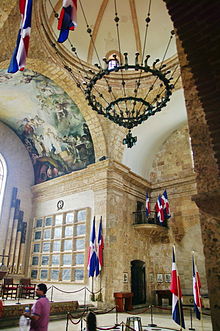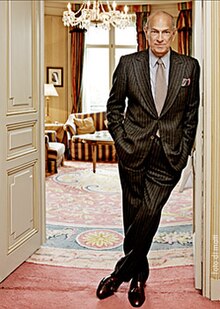Culture of the Dominican Republic
The Dominican people and their customs have origins consisting predominantly in a European cultural basis, with native Taíno and African influences.
Some common words derived from the Taino natives include: barbecue, canoe, caribbean, hammock, hurricane, iguana, manatee, mangrove, savannah, and tobacco among others.
During World War II, a group of Jews escaping Nazi Germany fled to the Dominican Republic and founded the city of Sosúa.
Some well-known merengue performers include Johnny Ventura, singer/songwriter Juan Luis Guerra, Fernando Villalona, Eddy Herrera, Sergio Vargas, Toño Rosario, Milly Quezada, and Chichí Peralta.
Merengue became popular in the United States, mostly on the East Coast, during the 1980s and 1990s,[6]: 375 when many Dominican artists, among them Víctor Roque y La Gran Manzana, Henry Hierro, Milly Jocelyn y Los Vecinos, residing in the U.S. (particularly New York) started performing in the Latin club scene and gained radio airplay.
[6]: 378 Bachata is a guitar-based genre that originated in the Dominican countryside and developed into a music style in urban Santo Domingo's shantytowns in the 1960s.
Early bachata drew influence from a wide range of Latin American genres, including Cuban bolero and son, Puerto Rican jíbaro music, Mexican corrido and ranchera, Colombian vals campesino and pasillo, and Dominican merengue.
In the 1970s and 1980s, bachata was dismissed by the Dominican elites due to its association with rural, working-class communities, its use of sexual innuendo, and the informal musical training of many performers.
Palos are related to Dominican folk Catholicism, which includes a pantheon of deities/saints (primarily known as misterios) much like those found in the African derived syncretic religious traditions of Cuba, Brazil, Haiti, and elsewhere.
During the late 1960s Dominican native Johnny Pacheco, creator of the famed Fania All Stars, played a significant role in the music's development and popularization, and is also credited for coining the term "Salsa" to denote the genre.
There are also several underground metal concerts occurring occasionally mainly in the cities of Santo Domingo and Santiago, where teenagers and young adults usually not satisfied with the other genres express themselves.
[7] A prolific musician and composer, Días' influence extends far beyond rock, leaving a lasting impact across multiple musical styles.
Dominican cuisine resembles that of other countries in Latin America, those of the nearby islands of Puerto Rico and Cuba, most of all, though the dish names differ sometimes.
Its most typical form, nicknamed La Bandera ("The Flag"), consists of rice, red beans and meat (beef, chicken, pork, or fish), sometimes accompanied by a side of salad.
The beverages Dominicans enjoy include Morir Soñando, rum, beer, Mama Juana, batida (smoothie), jugos naturales (freshly squeezed fruit juices), mabí, and coffee.
[9] The three highest paid baseball players of all time Alex Rodriguez, Albert Pujols, and Robinson Canó are of Dominican descent.
Olympic gold medalist and world champion hurdler Félix Sánchez hails from the Dominican Republic, as does NFL defensive end Luis Castillo.
The Taino people relied heavily on the mahogany and guano (dried palm tree leaf) to put together crafts, artwork, furniture, and houses.
Utilizing mud, thatched roofs, and mahogany trees give buildings and the furniture inside a natural look, seamlessly blending in with the island's surroundings.
[citation needed] Lately, with the rise in tourism and increasing popularity as a Caribbean vacation destination, architects in the Dominican Republic have now began to incorporate cutting-edge designs that emphasized luxury.
[citation needed] This new style, though diverse, is characterized by simplified, angular corners, and large windows that blend outdoor and indoor spaces.
[citation needed] Dominican art is perhaps most commonly associated with the bright, vibrant colors and images that are sold in every tourist gift shop across the country.
President Rafael Leónidas Trujillo provided asylum for Spanish Civil War refugees and a group of Europeans (including famous artists) subsequently arrived to the DR.
A need for a renewal of the image language emerged and, as a result, paintings were created in non-figurative, abstract, geometric and cubistic styles.
The most notable artists included Paul Giudicelli (1921–1965), Clara Ledesma (1924–1999), Gilberto Hernandez Ortega (1924–1979), Gaspar Mario Cruz (1925–2006), Luichy M. Richiez (1928–2000), Eligio Pichardo (1929–1984), Domingo Liz (b.
[citation needed] Dominican cinema is an emerging film industry, being one of the first countries in Latin America where the Lumière brothers first brought the Curiel theater in San Felipe de Puerto Plata at the beginning of the century in the year 1900, with the industry's beginnings dating back to 1915 in which the first film is produced in Dominican territory.
In June the country celebrates Espíritu Santo to honor the island's multi-ethnic heritage with nationwide festivals featuring traditional music.
Concerts, dance troupes, arts and crafts booths, and chefs also celebrate Dominican heritage with an annual cultural festival in Puerto Plata each June.
Each January the Dominican Republic honors Juan Pablo Duarte with gun salutes in Santo Domingo and numerous carnivals throughout the country.
[citation needed] During the event, hundreds of restaurants, food vendors, chefs, and others on the culinary scene host a series of presentations, tastings, and more.

















